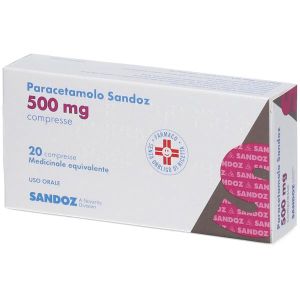Ship in Europe, Find out rates!
Language
Paracetamol Sandoz 20 Tablets 500mg

Regular Price
€5.04
Special Price
€3.35
-34%
Save: €1.69
In stock
Recent lowest price:
€2.86
- box Delivery in Italy in 24/48 and free returns
- star3.000+ positive reviews
- dropboxOver 60,000 products in the catalog
Manufacturer
SANDOZ
SKU
042360040
Active principle
PARACETAMOLO
NAME
PARACETAMOL SANDOZ TABLETS
PHARMACOTHERAPEUTIC CATEGORY
Analgesics, other analgesics and antipyretics, anilides.
ACTIVE PRINCIPLES
Paracetamol.
EXCIPIENTS
Povidone K-30 (E1201), pre-gelatinized starch (maize), sodium amidoglycolate (type A), stearic acid (E570).
INDICATIONS
500 mg tablets: mild to moderate pain and fever. 1000 mg tablets: Mild to moderate pain associated with osteoarthritis of the hip and knee.
CONTRAINDICATIONS / SECONDARY EFFECT
Hypersensitivity 'to the active substance or to any of the excipients.
DOSAGE
>> 500 mg tablets. Adults and children over 15 years: 1-2 tablets at a time, up to a maximum of 6 tablets in 24 hours. Children between 12 and 15 years (40-55 kg of body weight): 1 tablet at a time, 4-6 tablets in 24 hours. Children between 9 and 12 years (33-40 kg of body weight): 1 tablet at a time, 3-4 tablets in 24 hours. The minimum dosing interval should be 4 hours. Therefore, when pain symptoms recur, administration cannot be repeated before 4 hours have elapsed. Alcoholic patients: the maximum dosage of 4 tablets in 24 hours should not be exceeded. Method of administration: swallow the tablets with a sufficient quantity of water, or dissolve them in an adequate quantity of water, mix well and drink. Repeated administration is permitted, depending on the recurring symptoms (pain). >> 1000 mg tablets. Start with half a tablet (500 mg) and, if necessary, take 1 tablet (1000 mg); the maximum daily dose is 4 tablets (4000 mg). The minimum dosing interval should be 4 hours. Therefore, when pain symptoms recur, administration cannot be repeated before 4 hours have elapsed. Not for use in children under 15 years of age. Alcoholic patients: the maximum dosage of 2 tablets in 24 hours should not be exceeded. Method of administration: swallow the tablets with a sufficient quantity of water, or dissolve them in an adequate quantity of water, mix well and drink. Repeated administration is permitted, depending on the recurring symptoms (pain).
STORAGE
This medicine does not require any special storage conditions.
WARNINGS
Prolonged or frequent use is not recommended. Caution is advised in case of impaired liver and kidney function and chronic alcoholism; in these cases the daily dose should not exceed 2 g. A single administration several times of a dose higher than the maximum daily dose can seriously harm the liver, although no state of unconsciousness occurs, a doctor should be consulted immediately.
INTERACTIONS
Paracetamol can considerably increase the elimination half-life of chloramphenicol. Chronic simultaneous use of paracetamol and zidovudine increases the frequency of neutropenia, possibly due to decreased metabolism of zidovudine. Chronic alcohol abuse and the use of hepatic enzyme inducers, such as barbiturates, causes an increase in the severity of paracetamol overdose, due to the increase and acceleration of the formation of toxic metabolites.
SIDE EFFECTS
Few adverse effects occur with therapeutic dosages. Adverse events are listed below, divided by system organ class and by frequency. Frequencies are defined as: very common (> = 1/10), common (> = 1/100, <1/10), uncommon (> = 1/1000, <1/100), rare (> = 1 / 10,000, <1/1000), very rare (<1 / 10,000), not known (frequency cannot be estimated from the available data). Pathologies of the blood and lymphatic system. Rare: agranulocytosis (after prolonged use), thrombocytopenic purpura and haemolytic anemia. Disorders of the immune system. Uncommon: allergic reactions, especially rash, hives and fever. Hepatobiliary disorders. Dosages of paracetamol up to 7.5 g (in children doses above 140 mg / kg) can cause liver damage; larger quantities cause irreversible liver necrosis. Renal and urinary disorders. Very rare: in a single case, after very long-term use and at high doses, interstitial nephritis has been reported.
PREGNANCY AND BREASTFEEDING
Epidemiological studies on the oral use of therapeutic doses of paracetamol have shown no harmful effects on pregnancy or on the health of the fetus / newborn. At therapeutic dosages, paracetamol can 'be used during pregnancy. Paracetamol is excreted in small amounts in breast milk. No effect has been shown in breast-fed infants. Paracetamol can be used for a short time during breastfeeding, as long as the recommended dosages are not exceeded. In longer term use, caution should be advised.
PARACETAMOL SANDOZ TABLETS
PHARMACOTHERAPEUTIC CATEGORY
Analgesics, other analgesics and antipyretics, anilides.
ACTIVE PRINCIPLES
Paracetamol.
EXCIPIENTS
Povidone K-30 (E1201), pre-gelatinized starch (maize), sodium amidoglycolate (type A), stearic acid (E570).
INDICATIONS
500 mg tablets: mild to moderate pain and fever. 1000 mg tablets: Mild to moderate pain associated with osteoarthritis of the hip and knee.
CONTRAINDICATIONS / SECONDARY EFFECT
Hypersensitivity 'to the active substance or to any of the excipients.
DOSAGE
>> 500 mg tablets. Adults and children over 15 years: 1-2 tablets at a time, up to a maximum of 6 tablets in 24 hours. Children between 12 and 15 years (40-55 kg of body weight): 1 tablet at a time, 4-6 tablets in 24 hours. Children between 9 and 12 years (33-40 kg of body weight): 1 tablet at a time, 3-4 tablets in 24 hours. The minimum dosing interval should be 4 hours. Therefore, when pain symptoms recur, administration cannot be repeated before 4 hours have elapsed. Alcoholic patients: the maximum dosage of 4 tablets in 24 hours should not be exceeded. Method of administration: swallow the tablets with a sufficient quantity of water, or dissolve them in an adequate quantity of water, mix well and drink. Repeated administration is permitted, depending on the recurring symptoms (pain). >> 1000 mg tablets. Start with half a tablet (500 mg) and, if necessary, take 1 tablet (1000 mg); the maximum daily dose is 4 tablets (4000 mg). The minimum dosing interval should be 4 hours. Therefore, when pain symptoms recur, administration cannot be repeated before 4 hours have elapsed. Not for use in children under 15 years of age. Alcoholic patients: the maximum dosage of 2 tablets in 24 hours should not be exceeded. Method of administration: swallow the tablets with a sufficient quantity of water, or dissolve them in an adequate quantity of water, mix well and drink. Repeated administration is permitted, depending on the recurring symptoms (pain).
STORAGE
This medicine does not require any special storage conditions.
WARNINGS
Prolonged or frequent use is not recommended. Caution is advised in case of impaired liver and kidney function and chronic alcoholism; in these cases the daily dose should not exceed 2 g. A single administration several times of a dose higher than the maximum daily dose can seriously harm the liver, although no state of unconsciousness occurs, a doctor should be consulted immediately.
INTERACTIONS
Paracetamol can considerably increase the elimination half-life of chloramphenicol. Chronic simultaneous use of paracetamol and zidovudine increases the frequency of neutropenia, possibly due to decreased metabolism of zidovudine. Chronic alcohol abuse and the use of hepatic enzyme inducers, such as barbiturates, causes an increase in the severity of paracetamol overdose, due to the increase and acceleration of the formation of toxic metabolites.
SIDE EFFECTS
Few adverse effects occur with therapeutic dosages. Adverse events are listed below, divided by system organ class and by frequency. Frequencies are defined as: very common (> = 1/10), common (> = 1/100, <1/10), uncommon (> = 1/1000, <1/100), rare (> = 1 / 10,000, <1/1000), very rare (<1 / 10,000), not known (frequency cannot be estimated from the available data). Pathologies of the blood and lymphatic system. Rare: agranulocytosis (after prolonged use), thrombocytopenic purpura and haemolytic anemia. Disorders of the immune system. Uncommon: allergic reactions, especially rash, hives and fever. Hepatobiliary disorders. Dosages of paracetamol up to 7.5 g (in children doses above 140 mg / kg) can cause liver damage; larger quantities cause irreversible liver necrosis. Renal and urinary disorders. Very rare: in a single case, after very long-term use and at high doses, interstitial nephritis has been reported.
PREGNANCY AND BREASTFEEDING
Epidemiological studies on the oral use of therapeutic doses of paracetamol have shown no harmful effects on pregnancy or on the health of the fetus / newborn. At therapeutic dosages, paracetamol can 'be used during pregnancy. Paracetamol is excreted in small amounts in breast milk. No effect has been shown in breast-fed infants. Paracetamol can be used for a short time during breastfeeding, as long as the recommended dosages are not exceeded. In longer term use, caution should be advised.
| Destination | Cost | Detail |
|---|---|---|
| Italy | €5,90* | 24/72H |
| Austria, France, Germany, Slovenia | € 13* | 3 days |
| Belgium, Luxembourg, Portugal, Netherlands, Spain | € 14* | 4 days |
| Bulgary, Cechia, Hungary, Poland, Romania, Slovakia | € 19* | 5 days |
| Denmark, Estonia, Finland, Ireland, Lithuania, Latvia ,Sweden | € 22* | 5 days |
| United Kingdom, Switzerland, Greece, Malta/td> | € 30* | 7 days |
| Canada | € 40 | 7 Days |
European shipments with express courier: FedEx, MBE, DHL
*For the shipment outside band B ther's an extra cost of 22€ *For the shipment outside band C ther's an extra cost of 30€ Delivery Times exclude Saturday and Holidays
For Islands and Areas of difficult Accessibility the shipments are made in 72 hours and the cost will be increased by 15€
The images of the products shown on our site are purely indicative and may differ in shape, color, text and packaging shown on them. Given the difficulty of updating all the products on our site in real time or any errors, XFarma.it, all products will be identified through SKU MINSAN (code of the Ministry of Health).

